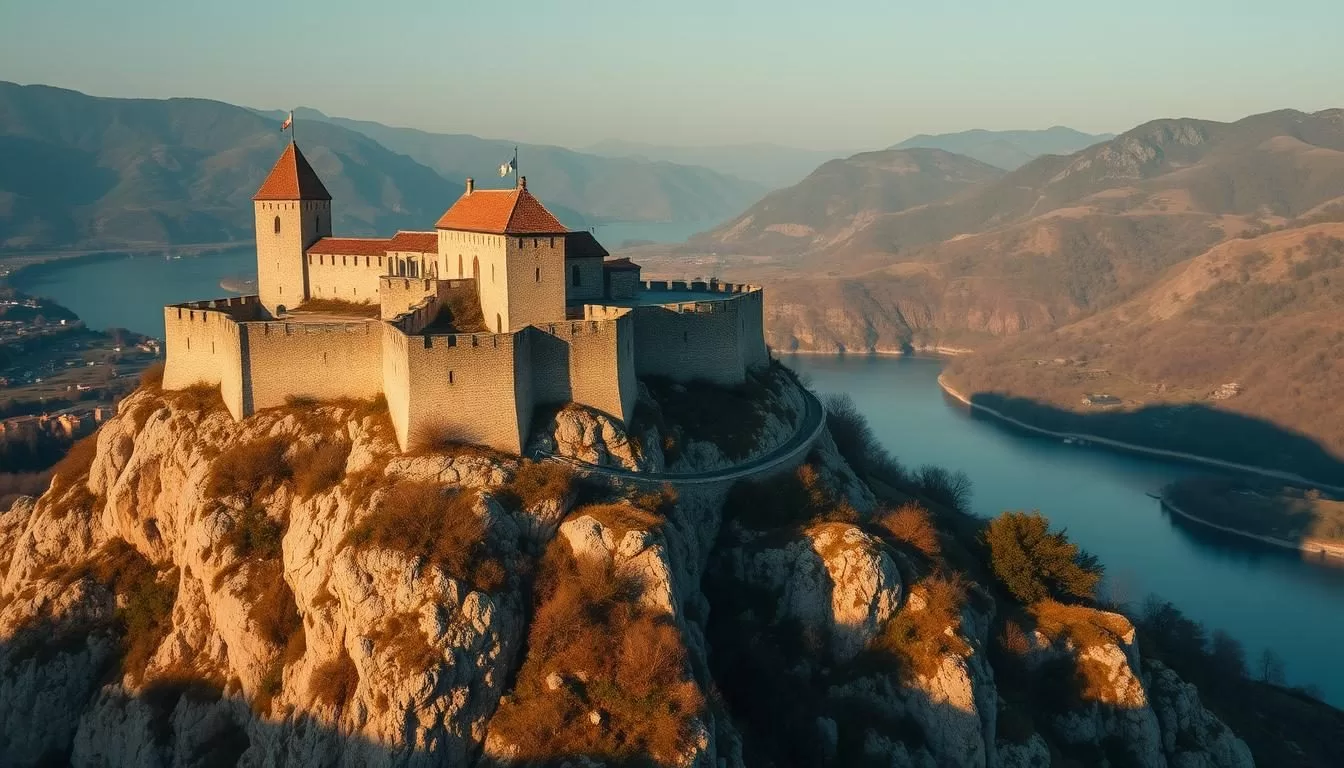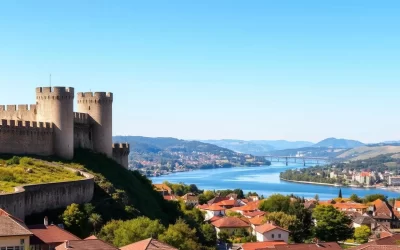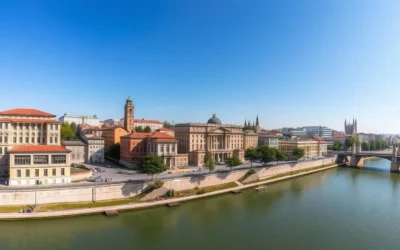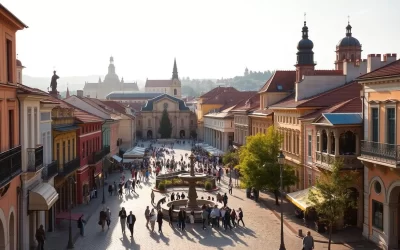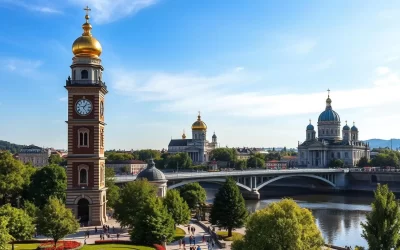✓ Accommodations✓ Flights✓ Rental Cars
Imagine a place where warm hospitality meets rich history and breathtaking natural beauty. You’re in for a treat as you explore Golubac, a charming town on the banks of the Danube River.
This hidden gem is becoming a hotspot for travelers seeking authentic experiences. With its unique blend of cultures, influenced by neighboring countries like Hungary and Rome, Golubac offers an unforgettable adventure.
From the magnificent Golubac Fortress to the stunning Iron Gate Gorge, you’ll discover a wealth of exciting activities and breathtaking sights. Whether you’re an adventure seeker, history buff, or nature lover, this town has something for everyone.
Discovering the Hidden Gem on the Danube
On the right bank of the Danube, you’ll find the picturesque town of Golubac, a hidden gem in Serbia. Built on a high, steep, and inaccessible rock, Golubac is a place where history and architecture come alive. The River Danube here is so wide that it almost looks like the sea, making it a breathtaking sight.
Golubac represents one of Serbia’s best-kept secrets, offering an authentic experience where you can immerse yourself in local culture while enjoying breathtaking landscapes. The town is small but charming, with friendly locals who welcome visitors with traditional Serbian hospitality, making every moment spent here memorable.
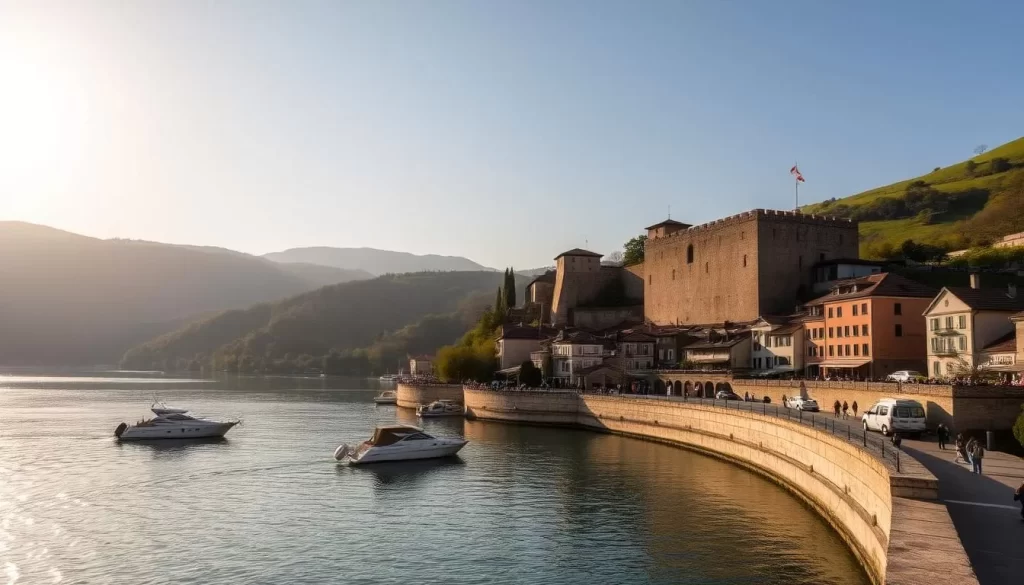
The strategic location of Golubac at the entrance to the Iron Gate gorge has made it an important settlement throughout history. Today, it serves as a gateway to some of Serbia’s most spectacular natural and historical attractions. Recent infrastructure improvements have made Golubac more accessible than ever, transforming it from an overlooked spot to a rising star on Serbia’s tourism map.
You’ll find that Golubac is the perfect base for exploring the surrounding region, with day trips to numerous attractions easily arranged from this central location. The town combines the best of Serbia’s natural beauty, rich history, and cultural heritage in one compact, visitor-friendly place.
| Attraction | Description | Time to Visit |
|---|---|---|
| Golubac Fortress | A medieval fortress straight out of fairytales | Morning |
| Iron Gate Gorge | A spectacular natural wonder on the Danube | Afternoon |
| Local Culture | Experience traditional Serbian hospitality | Any time |
In summary, Golubac is a town that offers a unique blend of history, culture, and natural beauty, making it a must-visit destination in Serbia at any time of the year.
The Magnificent Golubac Fortress: A Medieval Marvel
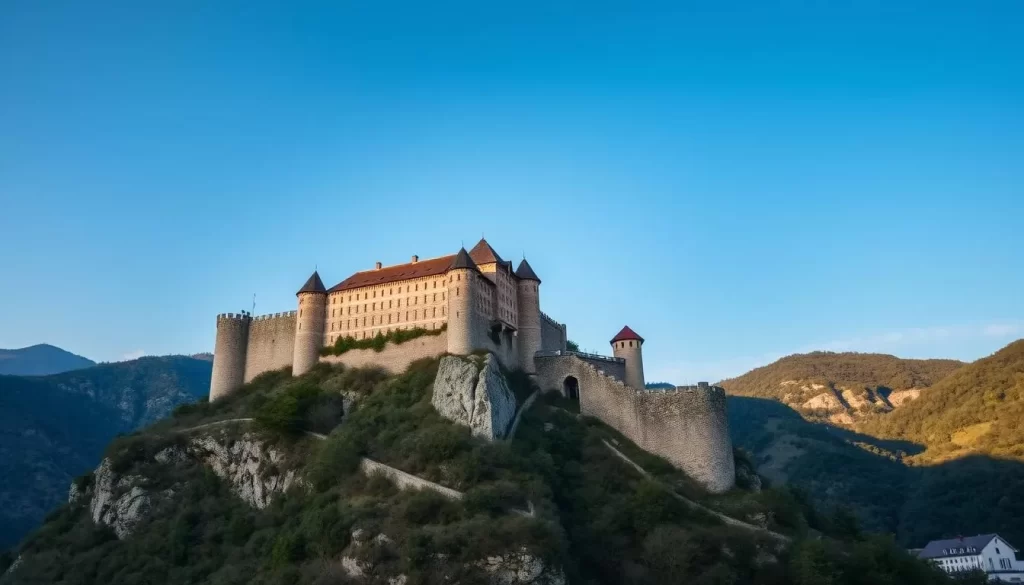
As you approach the Iron Gate gorge, the imposing Golubac Fortress comes into view, standing sentinel over the Danube River. This medieval marvel, with its ten towers rising dramatically above the Danube, is a testament to the region’s rich history and architectural prowess.
The Golubac Fortress dates back to the 14th century, a period marked by the rise and fall of various empires and dynasties in the region. Throughout its turbulent past, it has changed hands numerous times, being controlled by Serbians, Hungarians, Austrians, and Ottomans at different points in time. Despite these changes, the fortress remains a key part of Serbia’s history.
Golubac Fortress has undergone extensive restoration work, transforming it into a world-class tourist attraction. Today, visitors can explore its various levels, towers, and walls, each offering spectacular panoramic views of the Danube. The fortress museum provides fascinating insights into its strategic importance throughout the years, and interactive exhibits help bring the past to life.
You can spend an entire day exploring the fortress, discovering its secrets, and enjoying the cultural events and festivals it hosts throughout the year. The fortress is particularly photogenic at sunset when the ancient stone walls glow golden against the backdrop of the Danube waters, making it a must-visit destination in Serbia.
Exploring the Iron Gate Gorge: Natural Wonder
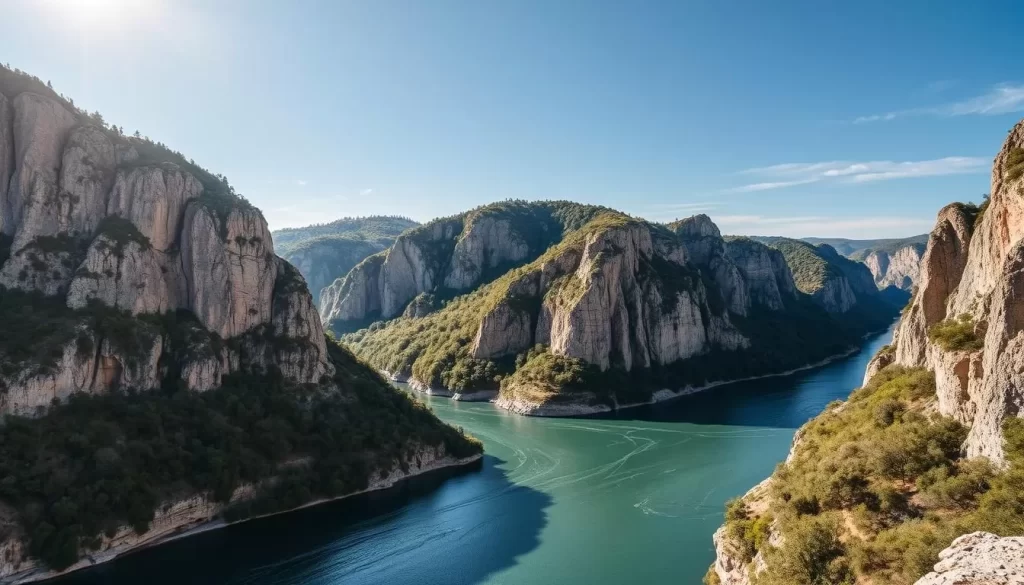
One of Europe’s most spectacular natural wonders, the Iron Gate Gorge, awaits your visit. Located on the border between Serbia and Romania, this impressive gorge stretches for nearly 100 kilometers, forming a natural boundary between the two countries.
The mighty Danube River has carved its way through the Carpathian Mountains, creating dramatic limestone cliffs that tower over the water. As you navigate through the gorge, you’ll be struck by the sheer scale of this natural wonder. The Iron Gate is partially submerged due to the construction of hydroelectric dams, creating a deep, lake-like environment that’s perfect for river tours.
As you explore the Iron Gate Gorge, you’ll notice the diverse ecosystem that has developed around this unique place. Numerous bird species make their home in this environment, making it a haven for wildlife enthusiasts. The gorge represents a significant geographical and ecological boundary, marking the point where the Middle Danube transitions to the Lower Danube.
For adventure seekers, kayaking through portions of the Iron Gate provides an intimate connection with this powerful natural environment. However, it’s essential to check river conditions in advance to ensure a safe and enjoyable experience. The changing light throughout the day creates a dramatic landscape, making this a photographer’s paradise.
Today, you can experience the Iron Gate Gorge through boat tours departing from Golubac, with knowledgeable guides pointing out interesting geological features and historical points along the journey. Whether you’re looking to explore this natural wonder or simply take in its beauty, the Iron Gate Gorge is an unforgettable experience that awaits you at this time.
Đerdap National Park: Serbia’s Natural Treasure
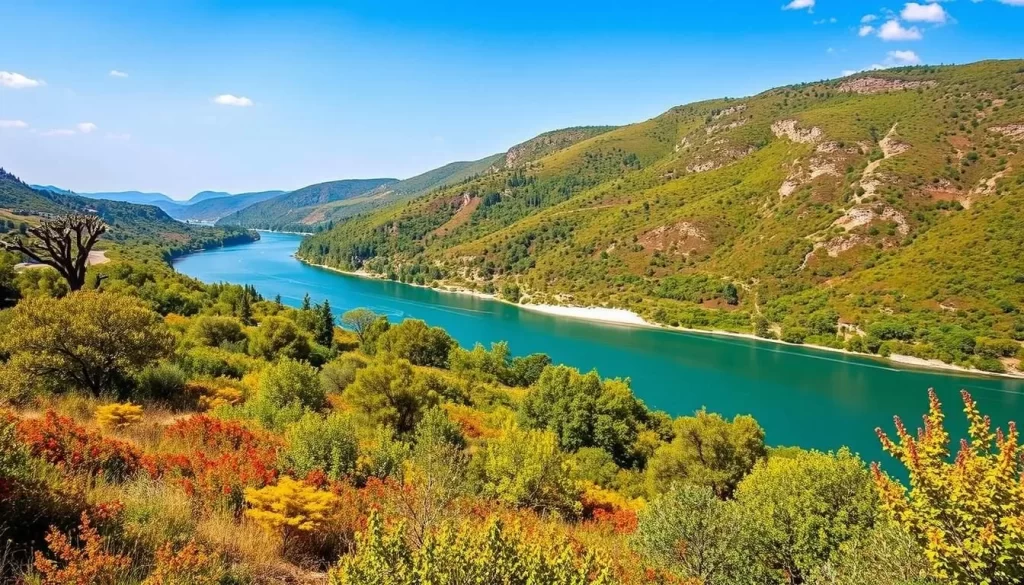
Đerdap National Park, also known as the ‘Iron Gate National Park,’ is a marvel of natural beauty and biodiversity. Stretching along the Danube River, it is Serbia’s largest national park, covering an impressive 63,000 hectares of diverse landscapes.
The park’s centerpiece is the stunning Đerdap Gorge, or Iron Gate, a natural marvel celebrated for its geological significance. This wonder of nature is renowned for its rich biodiversity and ancient archaeological sites.
With over 1,100 plant species and numerous animal species, including golden eagles, lynx, and the rare Danube sturgeon, the park is a living laboratory for scientists and nature enthusiasts. The unique microclimate created by the interaction of mountain and river environments has fostered the development of unusual ecological niches.
Visitors can explore the park through an extensive network of hiking trails that offer spectacular views of the Danube’s waters from various vantage points along the cliffs and mountain ridges. The park’s visitor centers provide educational exhibits about the region’s geology, ecology, and cultural history.
Beyond natural wonders, Đerdap National Park protects important cultural and historical sites, including prehistoric settlements, Roman fortifications, and medieval monasteries. Conservation efforts focus on preserving the delicate balance between human activity and natural processes.
The artificial lakes within the park boundaries have created new recreational opportunities while serving as important habitats for aquatic species. As you explore this remarkable national park, you’ll gain a deeper appreciation for its natural treasure.
Kayaking Adventures on the Danube River
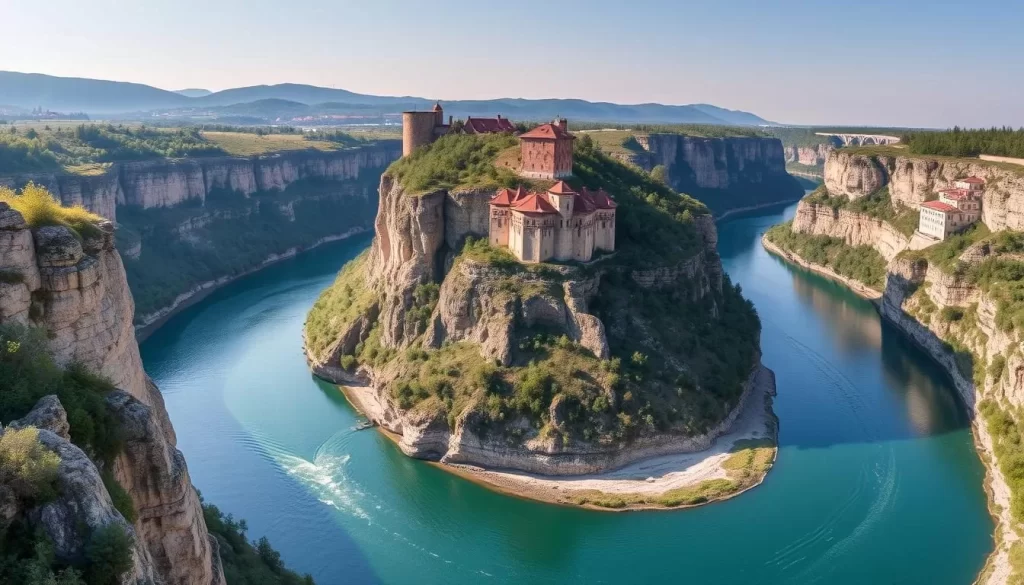
Kayaking from Golubac to Donji Milanovac offers an unforgettable adventure through one of Europe’s most spectacular river canyons. As you paddle along the Danube River, you’ll experience the natural beauty of the Iron Gate, a stunning gorge that forms part of the border between Romania and Serbia.
The journey provides varied paddling experiences, from calm, lake-like waters near Golubac to more challenging sections where the river narrows through gorges like the Gospogdin Vir Gorge. Along the way, you’ll encounter dramatic cliff formations, hidden beaches, and small caves that are inaccessible by land.
Local outfitters in Golubac offer kayak rentals and guided tours suitable for different skill levels, making this adventure accessible even for beginners. For experienced kayakers, the route from Golubac to Donji Milanovac covers approximately 50 kilometers of diverse river landscapes, providing an exciting challenge.
As you kayak, keep an eye out for wildlife, including various bird species and other animals that come to the river to drink. The unique vantage point of a kayak offers opportunities to spot these creatures in their natural habitat.
Safety is paramount when kayaking on the Danube River, as weather conditions can change quickly and commercial shipping traffic uses the main channel. Guided tours are recommended for those unfamiliar with the area, ensuring a safe and enjoyable experience.
For a more extended adventure, multi-day kayaking trips can be arranged with camping stops at designated places along the river. This allows you to fully immerse yourself in the natural beauty of the Iron Gate and surrounding landscapes.
Hiking Trails Around Golubac: Paths Less Traveled
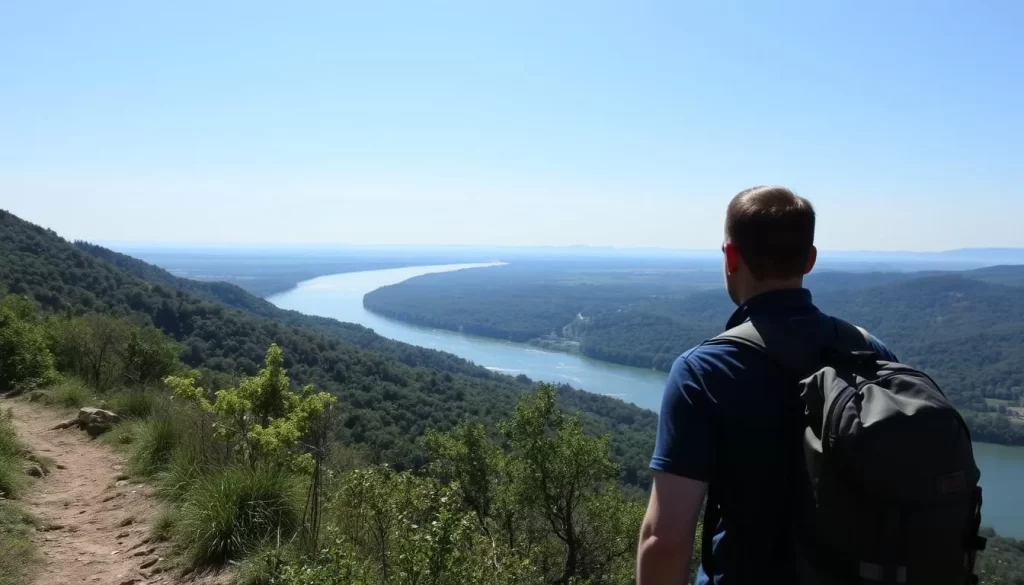
With its diverse landscapes and scenic views, Golubac’s hiking trails are a must-visit for outdoor enthusiasts. The trails around Golubac offer a perfect complement to water-based activities, taking you through diverse landscapes from riverside paths to elevated viewpoints overlooking the Danube.
Many trails begin right from the town center, making them easily accessible for visitors staying in Golubac, while others require short drives to trailheads in nearby villages. The network of paths ranges from easy walks suitable for families to more challenging routes that reward hikers with spectacular panoramic views after a few hours of effort.
One of the most popular trails leads from Golubac to viewpoints above the fortress, offering unique perspectives of this medieval structure against the backdrop of the widening Danube. For more adventurous hikers, the trails extending into Đerdap National Park provide opportunities to explore dense forests, encounter local wildlife, and discover hidden viewpoints far from the tourist crowds.
Today, many of these trails follow ancient paths that have been used by locals for centuries, adding a historical dimension to your hiking experience. Spring and fall offer the most pleasant hiking conditions, with moderate temperatures and spectacular colors that transform the landscape throughout the day. Local guides can enhance your hiking experience by pointing out interesting flora and fauna, sharing stories about the place, and leading you to special points that might be difficult to find on your own.
Historical Sites Beyond the Fortress
Beyond the imposing Golubac Fortress, the region is home to a wealth of historical sites that offer a deeper understanding of the area’s rich cultural heritage. You can explore these sites to gain a more comprehensive insight into the history and culture of Golubac.
Tumane Monastery
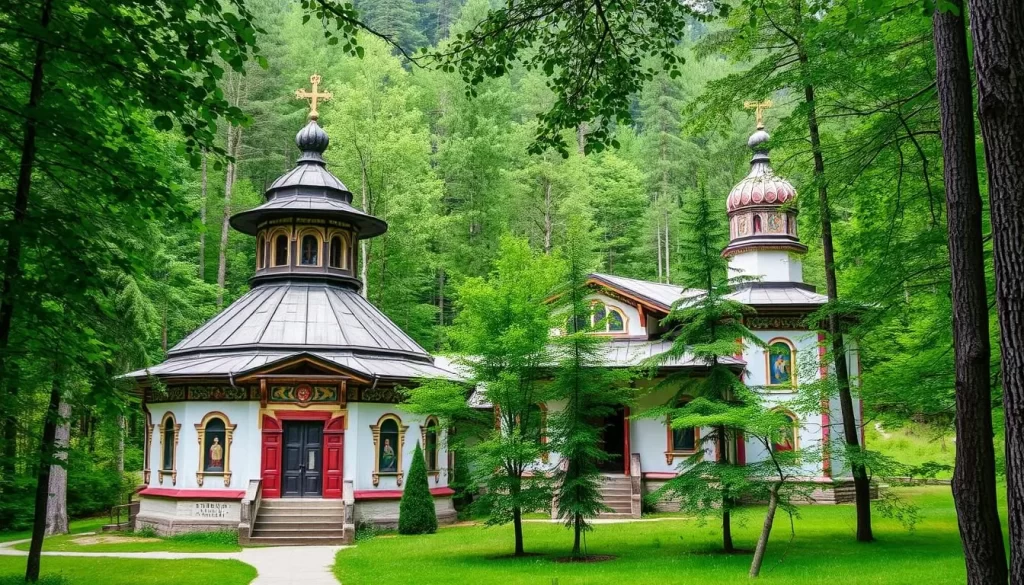
Tumane Monastery, located just 10 kilometers from Golubac, is a spiritual oasis that dates back to the 14th century. The monastery’s peaceful setting among forested hills creates a contemplative atmosphere, while its interior showcases beautiful frescoes that have been carefully preserved through the years. This monastery is a cherished spiritual sanctuary, exuding an aura of tranquility while showcasing amazing architectural elegance.
Lepenski Vir Archaeological Site
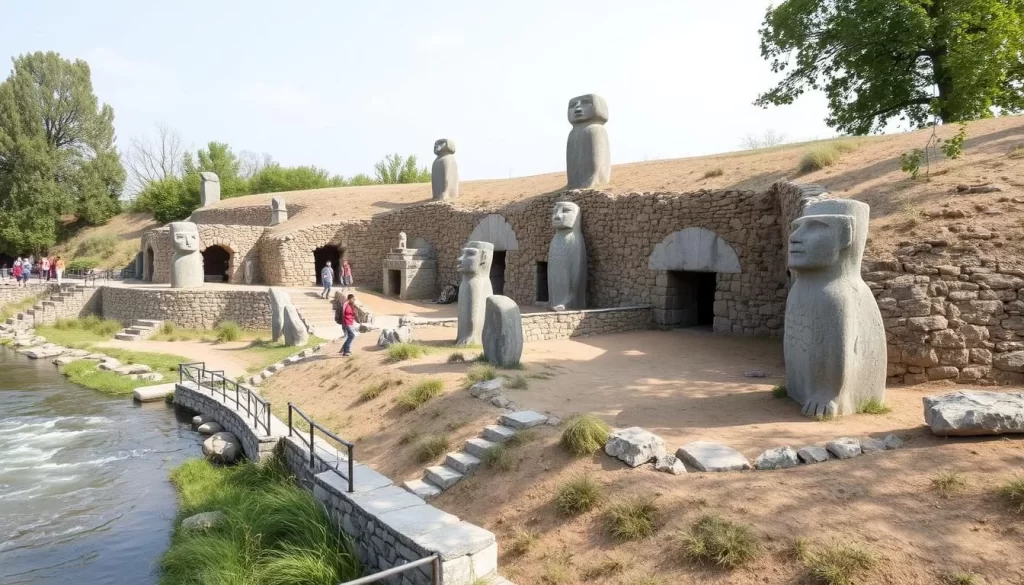
Lepenski Vir, nestled on the banks of the Danube River in Serbia, is an exceptional archaeological site dating back to 7000 BC. As one of the oldest settlements in Europe, it continues to intrigue researchers, providing rare pieces of evidence of the earliest human civilization. The site features remarkable stone sculptures portraying abstract creatures, which show the spiritual beliefs of early inhabitants.
Visiting these historical sites provides a unique glimpse into the region’s rich history and cultural heritage. From the medieval architecture of Tumane Monastery to the ancient artifacts of Lepenski Vir, you can explore the diverse historical attractions that collectively tell the story of human habitation in this strategic Danube region across thousands of years.
Golubac, Serbia: Best Things to Do – Top Picks for Nature Lovers
Nature enthusiasts will find Golubac, Serbia, to be an unspoiled gem, rich in biodiversity. The region offers a diverse range of ecosystems, from the mighty Danube waters to mountain forests and everything in between.
Miroc Mountain Exploration

Miroc Mountain, often referred to as “the forgotten heaven,” is a natural miracle stretching over 300 square kilometers. It is here that the Danube twists and turns through the rocky cliffs of Djerdap canyon, now a National Park. To climb the highest peak, Great Strbac, which is 768 meters tall, one needs to obtain a permit. The mountain offers some of the region’s most rewarding hiking experiences, with trails leading to spectacular viewpoints overlooking the Danube’s path through the Iron Gate.
You can explore the lesser-known peaks like Mali Vis and Visoki Čukar, which provide excellent alternatives with fewer visitors but equally impressive vistas, making them perfect spots for solitude seekers. Today, the mountain’s extensive network of marked trails allows for day hikes of varying difficulty, with Donji Milanovac serving as an excellent base for exploring the eastern sections.
Birdwatching Opportunities
The unique microclimate created by the mountains and the Danube has fostered rich biodiversity, making this area a hotspot for birdwatching enthusiasts. Over 200 bird species have been recorded in the region, including rare raptors like the white-tailed eagle and peregrine falcon that nest on the cliffs above the water. Spring and fall migrations bring additional species through the area, creating seasonal birdwatching opportunities that attract ornithologists from across Europe.
Local guides in Golubac and Donji Milanovac can lead specialized birdwatching tours to the best observation spots, providing expertise and equipment for optimal viewing experiences. Beyond birds, the region’s diverse habitats support numerous other wildlife species, from deer and wild boar in the forests to the various fish species in the lake-like sections of the Danube.
Local Cuisine: Taste of Serbian Danube
Savoring the local cuisine in Golubac is an experience that combines traditional Serbian flavors with the freshest Danube delicacies. The cuisine of this region is shaped by its unique geographical position, blending influences from neighboring countries and incorporating the bounty of the river.
Traditional Dishes to Try
The riverside location of Golubac makes fish dishes a centerpiece of the local cuisine. You should try specialties like smuđ (pike-perch) and som (catfish), prepared according to traditional recipes. Another must-try is riblja čorba (fish soup), known for its distinctive red color and complex flavors, often served as the opening course of a proper Serbian meal. Beyond fish, hearty meat dishes like karađorđeva šnicla (breaded veal or pork stuffed with kajmak cheese) showcase the Serbian love of open-flame cooking.
Local produce plays a significant role in the regional cuisine, with seasonal vegetables and fruits from nearby farms enhancing the flavors of dishes throughout the year. This makes every visit to Golubac a new culinary experience, depending on the time of year you choose to visit.
Best Restaurants in Golubac
When in Golubac, you’ll find that the best restaurants combine traditional recipes with modern presentation, often featuring outdoor terraces with views of the Danube that enhance your dining experience. Restaurant Aquastar Danube is a popular spot for both locals and visitors, offering excellent fish specialties and a prime location near the water. For a more casual meal, konoba-style establishments in town serve simple but delicious local fare in a relaxed atmosphere, perfect for a leisurely lunch after a day of exploration.
Don’t miss the opportunity to pair your meal with local wines from the nearby Negotin wine region, known for its distinctive varieties since Roman times. Whether you’re dining at home or in one of Golubac’s restaurants, the taste of Serbian Danube cuisine is sure to leave a lasting impression.
Day Trips from Golubac
Golubac’s strategic location makes it an ideal base for exploring the rich history and natural beauty of eastern Serbia. The surrounding area is filled with exciting destinations that are perfect for day trips.
Donji Milanovac
Located 50 kilometers downstream from Golubac, Donji Milanovac is another gateway to Đerdap National Park, offering its own unique charm and visitor facilities. This picturesque town has a more developed tourism infrastructure than Golubac, with several hotels, restaurants, and a beautiful promenade along the Danube.
Donji Milanovac is home to the Visitor Center for Đerdap National Park, where you can gather information about hiking trails and arrange boat tours to view the most impressive sections of the Iron Gate. The town is also the closest base for visiting the Lepenski Vir archaeological site, making it a convenient stop for history enthusiasts.
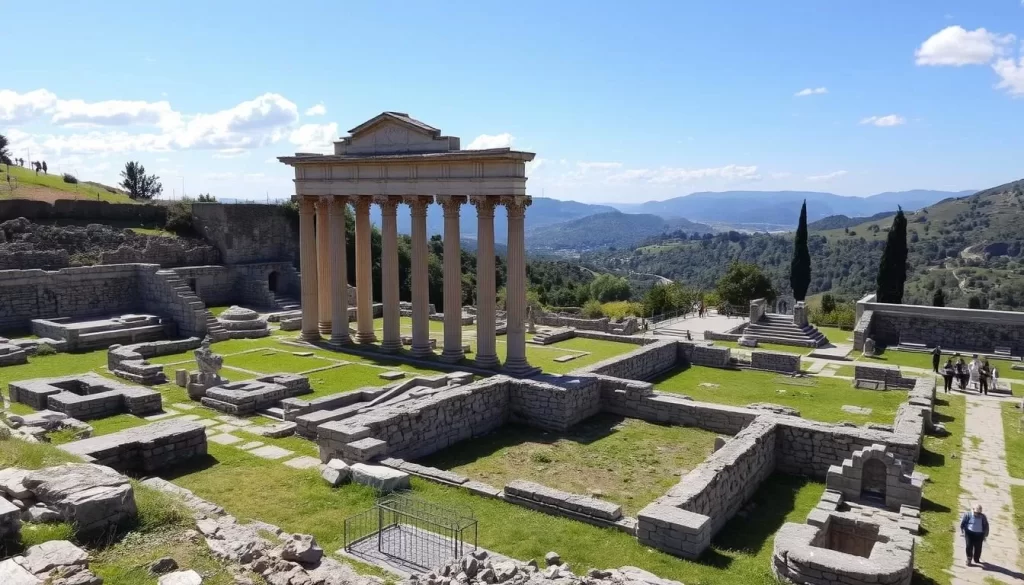
Viminacium Archaeological Park
Viminacium Archaeological Park, located near Kostolac about 80 kilometers from Golubac, preserves the remains of a major Roman city and military camp that once housed 40,000 inhabitants. This impressive site features excavated amphitheaters, baths, streets, and one of the largest Roman cemeteries in the Balkans, offering a fascinating glimpse into provincial Roman life.
If you have been mesmerized by the Romans, their history and culture, Viminacium is the place to be. Serbia played an important role in the Roman Empire, and this archaeological park gives visitors a vivid picture of the past.
Other potential day trips from Golubac include a visit to Belgrade, where you can explore attractions like Knez Mihailova Street and the Belgrade City Library. Novi Sad, Serbia’s second-largest city, is another option, known for its Petrovaradin Fortress and charming old town, although this requires a longer drive.
Where to Stay: Accommodation Options
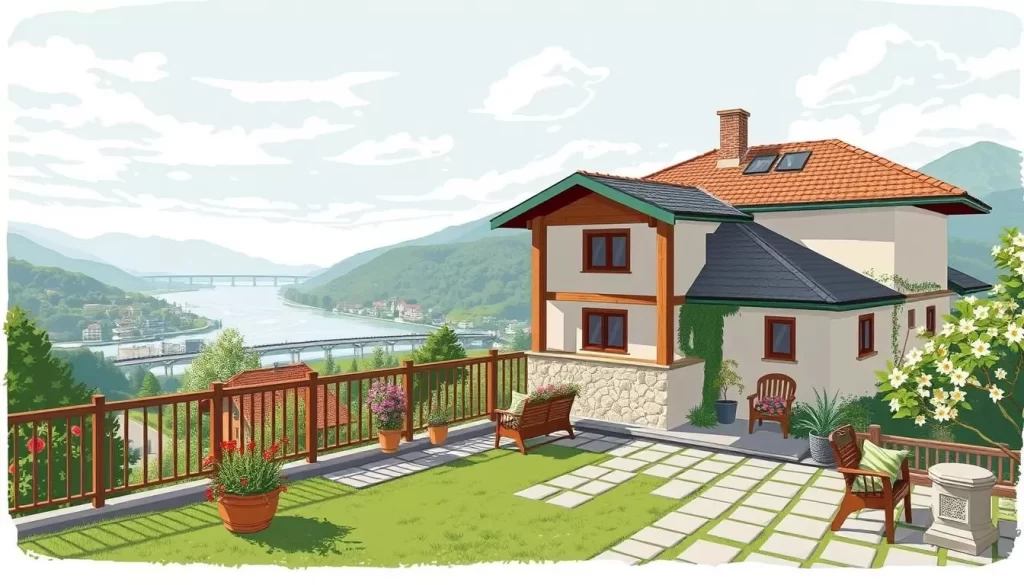
The charming town of Golubac has seen an expansion in its accommodation options in recent years. While it has grown, Golubac still maintains its authentic character without the large resort developments found in more commercialized destinations.
Small, family-run guesthouses, or pansions, represent the most common and authentic accommodation option in Golubac. These establishments offer comfortable rooms and often include home-cooked breakfast featuring local specialties. You can enjoy stunning views of the Danube from several waterfront properties, relaxing on terraces while watching boats pass by after a day of exploration.
For those seeking more amenities, Hotel Golubački grad is a popular choice, offering comfortable rooms, an on-site restaurant, and a convenient location near the fortress. Budget-conscious travelers can find affordable private accommodations in town, many of which have been renovated to provide modern comforts while maintaining traditional Serbian hospitality.
Outdoor enthusiasts can opt for camping along the Danube, pitching a tent and enjoying the sounds of the river. For a wider range of accommodations, nearby Donji Milanovac offers additional choices, including the larger Hotel Lepenski Vir with its wellness facilities and river views. Many local accommodations can help arrange activities like boat tours, fishing trips, and guided hikes.
Booking ahead is essential, especially during summer months and weekends, as the limited number of rooms in Golubac can fill quickly, particularly today as the destination grows in popularity. Regardless of where you stay, Serbian hospitality ensures you’ll feel welcome, with hosts often going above and beyond to make your visit memorable.
Best Time to Visit Golubac
The best time to visit Golubac depends on your preferences, as this Serbian town on the Danube River boasts a moderate continental climate.
Golubac enjoys four distinct seasons, each offering a different experience for visitors. Late spring (May to early June) is one of the best times to visit, with comfortable temperatures and lush green landscapes, making it ideal for outdoor activities.
In contrast, summer (late June through August) brings the warmest temperatures and the most visitors, making it perfect for water activities on the Danube. However, it’s also the busiest time of year at popular spots like Golubac Fortress.
Early autumn (September to mid-October) is another prime time to visit, with pleasant weather and spectacular fall colors in the surrounding forests. If you prefer fewer crowds, consider visiting during the weekdays.

Winter visits have their own charm, with the fortress and landscapes often dusted with snow, creating a dramatic backdrop for photography. However, some activities may be limited, and some smaller accommodations may close for part of the season.
Today, climate change has made weather patterns less predictable, so checking forecasts before your trip is advisable. Various events throughout the year, including cultural festivals and sporting competitions, can also affect visitor numbers, making it worthwhile to check the local event calendar when planning your trip.
Practical Travel Tips for Visiting Golubac
To make the most of your trip to Golubac, Serbia, it’s essential to be prepared with practical travel tips. Planning your visit requires some preparation, especially regarding transportation, as public transit options are limited compared to more developed tourist destinations.
Getting There
Getting to Golubac is most straightforward by car, with the drive from Belgrade taking approximately 2 hours along a scenic route that follows part of the Danube’s course. Public buses connect Belgrade to Golubac several times daily, with the journey taking about 2.5-3 hours depending on the route and number of stops. For international tourists, renting a car in Belgrade offers the most flexibility for exploring Golubac and the surrounding region, including Donji Milanovac, at your own pace.
Getting Around
Getting around Golubac itself is easily done on foot, as the town is compact, but exploring beyond the immediate area requires transportation. Local taxis can be arranged for shorter trips, while day tours with transportation included are available for visits to attractions like Lepenski Vir or Donji Milanovac. Bicycle rentals provide an excellent option during warmer months, with the road along the Danube offering spectacular views and moderate terrain suitable for casual cyclists.
Essential Information
It’s crucial to know that while credit cards are accepted at larger establishments, carrying some Serbian dinars is advisable for smaller shops and cafes. Mobile coverage is generally good in Golubac and along the main roads, but can be spotty in more remote parts of Đerdap National Park. The local tourist information center in Golubac provides maps, brochures, and up-to-date information about attractions and events, making it a valuable first stop upon arrival. You can plan your day according to the opening hours of the attractions you wish to visit.
| Mode of Transport | Description | Duration/Availability |
|---|---|---|
| By Car | Scenic route from Belgrade along the Danube | Approximately 2 hours |
| Public Bus | Several daily services from Belgrade | 2.5-3 hours |
| Taxi | Local taxis for shorter trips | Available upon request |
| Bicycle Rental | Explore Golubac and surroundings | Available during warmer months |
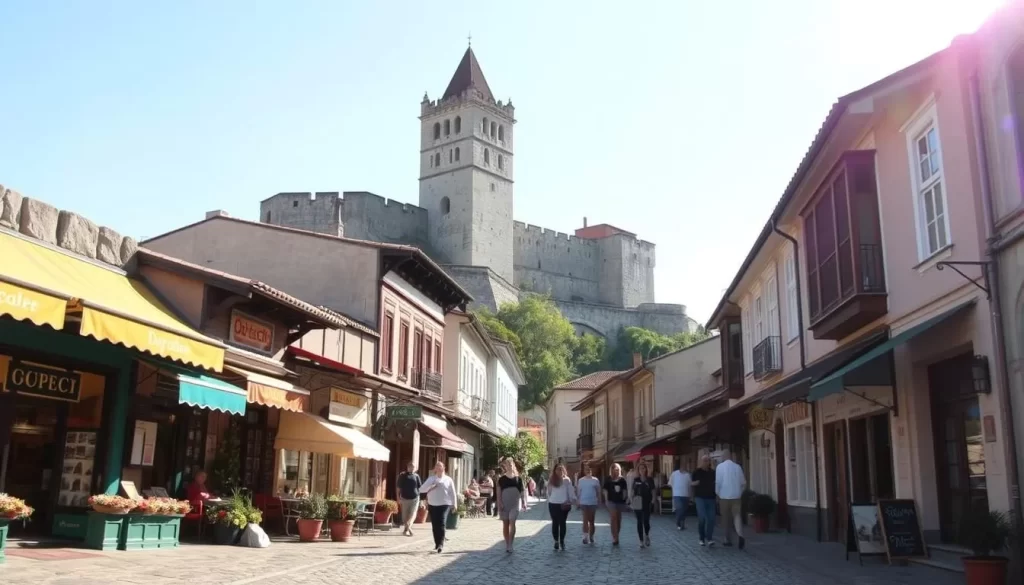
Cultural Experiences and Events
Visitors to Golubac can immerse themselves in local culture through numerous festivals and workshops. The town’s cultural calendar is filled with exciting events that showcase Serbian traditions and contemporary life, making it an ideal destination for those seeking a rich cultural experience.
Local festivals play a significant role in Golubac’s cultural scene. These events celebrate historical commemorations, seasonal harvests, and the region’s heritage, featuring music, dance, food, and crafts. The Golubac Fortress Festival, held every year in summer, is a highlight, with historical reenactments, traditional music performances, and artisan markets that bring the fortress and its history to life.
Local Festivals
Local festivals in Golubac and nearby towns are a testament to the region’s vibrant culture. The Golubac Fortress Festival is a major event that takes place every summer, featuring historical reenactments and traditional music. Additionally, fishing festivals along the Danube River celebrate the river’s importance to local culture, with competitions, demonstrations of traditional fishing techniques, and freshly prepared fish dishes.
| Festival | Time of Year | Main Attractions |
|---|---|---|
| Golubac Fortress Festival | Summer | Historical reenactments, traditional music, artisan markets |
| Fishing Festivals | Varies | Fishing competitions, traditional fishing techniques, local cuisine |
Cultural Workshops
Cultural workshops offer hands-on experiences for visitors interested in traditional crafts. Local artisans teach skills such as weaving, pottery, and traditional food preparation. You can participate in cooking classes that focus on regional specialties, providing both culinary education and a delicious meal. Art workshops inspired by the region’s landscapes and cultural heritage offer creative outlets for visitors.
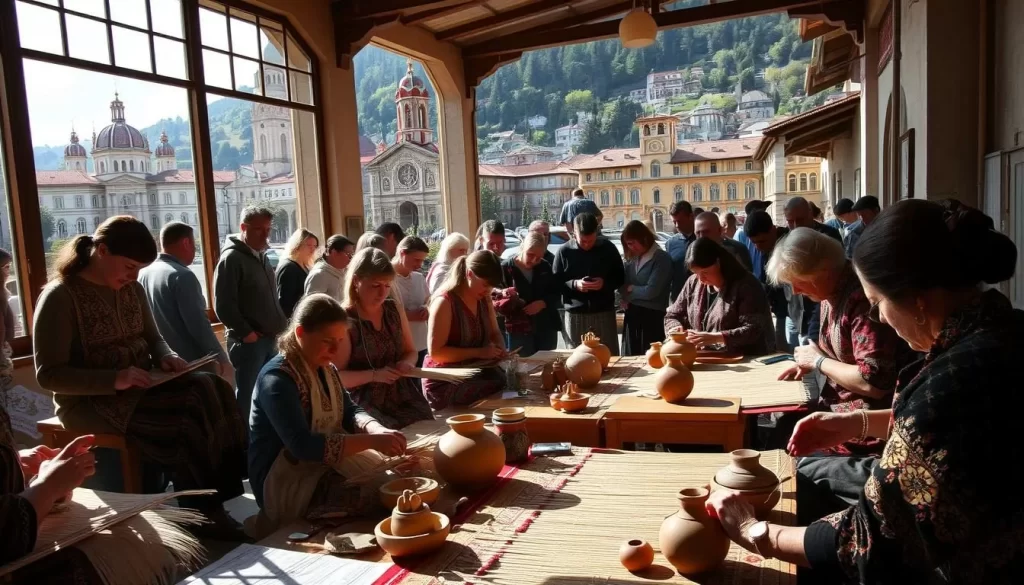
Today, many of these cultural experiences can be arranged through accommodations or the local tourism office, making them accessible even for short-term visitors. Whether you’re interested in music, crafts, or local cuisine, Golubac has something to offer, enriching your travel experience with memorable cultural encounters.
Conclusion: Why Golubac Should Be on Your Serbian Itinerary
Golubac, a hidden gem on the Danube, offers an unforgettable experience that blends natural beauty with rich history. As you’ve explored throughout this guide, Golubac is a standout destination in Serbia, even though it remains less known than some of the country’s other attractions.
The combination of the magnificent Golubac Fortress, the dramatic Iron Gate gorge, and the biodiversity of Đerdap National Park creates a destination that appeals to multiple interests. Every day spent here can be filled with new discoveries, from kayaking on the Danube to hiking in the surrounding mountains.
Golubac serves as an ideal gateway to explore eastern Serbia, with convenient access to sites like Lepenski Vir and Donji Milanovac. The relative lack of overtourism in this part of Serbia means you can enjoy these remarkable attractions without the crowds, creating more meaningful connections with the place and its people.
As you return home from Golubac, you’ll carry with you not just photographs but a deeper understanding of Serbia’s natural wonders, historical significance, and cultural richness. Including Golubac in your Serbian itinerary provides balance to urban experiences in Belgrade or Novi Sad, showcasing the country’s diverse landscapes and the different pace of life in its smaller communities.
Whether you’re watching the sunset over the Danube from the fortress walls or sharing a meal with locals, the memories you’ll create here will become cherished moments from your travels. Golubac is a part of Serbia that maintains strong connections to traditional ways of life, offering authentic experiences that feel genuinely local.
The above is subject to change.
Check back often to TRAVEL.COM for the latest travel tips and deals.
